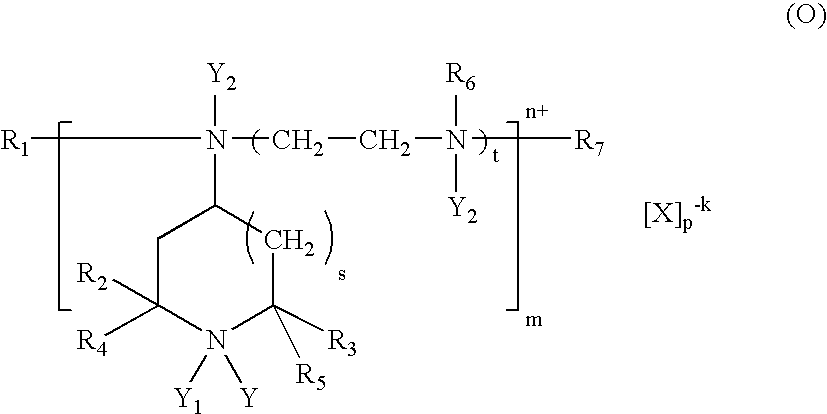Light-stable and process-stable lignocellulosic materials and their production
a technology of lignocellulosic materials and process stability, which is applied in the field of production of lightstable and process-stable lignocellulosic materials, can solve the problems of further brightness loss, reduced pulp brightness, and limited application of mechanical pulps to products, so as to improve light and process stability, the effect of improving the light and process stability
- Summary
- Abstract
- Description
- Claims
- Application Information
AI Technical Summary
Benefits of technology
Problems solved by technology
Method used
Image
Examples
example 1
[0089] Samples of an aspen BCTMP pulp (ISO brightness=82.8%) were reacted at room temperature (˜20° C.) and pH 6.5-7.0, according to the general procedure C disclosed above, with 0.5% (on OD pulp) of 4-amino-2,2,6,6-tetramethylpiperidine-N-oxyl (4-amino-TEMPO), and with 1.0% (on OD pulp) of N-(2,2,6,6-tetramethyl-1-oxyl -piperidin-4-yl)-N′-{2-[2-(2,2,6,6-tetramethyl-1-oxyl-piperidin-4-ylamino)-ethylamino]-ethyl}-ethane-1,2-diamine (abbreviated as TETA-2TEMPO) synthesized according to the general procedure A disclosed above, respectively. Portions of the 4-amino-TEMPO-reacted pulp and the TETA-2TEMPO-reacted pulp were treated with 1.0% (on OD pulp) of calcium chloride according to the general procedure F disclosed above. Table 1 shows the PC number of the various pulps vs. the ambient light exposure times. The pulp reacted with 4-amino-TEMPO shows much improved brightness stability but loses most of the improved brightness stability after treatment in an aqueous medium containing cal...
example 2
[0090] Samples of an aspen BCTMP pulp (ISO brightness=82.8%, total nitrogen content=0.028% on OD pulp) were reacted at room temperature (a 20° C.) and pH 6.5-7.0, according to the general procedure C disclosed above, with 0.5% (on OD pulp) of 4-amino-2,2,6,6-tetramethyl-N-hydroxyl-piperidine dihydrochloride (abbreviated as 4-amino-TEMPOH-2HCl), and with 1.0% (on OD pulp) of N-(2,2,6,6-tetramethyl-1-hydroxyl-piperidin-4-yl)-N′-{2-[2-(2,2,6,6-tetramethyl-1-hydroxyl-piperidin-4-ylamino)-ethylamino]-ethyl}-ethane-1,2-diamine hexahydrochloride (abbreviated as TETA-2TEMPOH-6HCl), respectively. Both 4-amino-TEMPOH-2HCl and TETA-2TEMPOH-6HCl were synthesized according to the general procedure B disclosed above. Portions of the 4-amino-TEMPOH-2HCl-reacted pulp and the TETA-2TEMPOH-6HCl-reacted pulp were treated with 1.0% (on OD pulp) of calcium chloride according to the general procedure F disclosed above. Table 2.1 and Table 2.2 show the PC number and the ISO brightness, respectively, of th...
example 3
[0092] Samples of an aspen BCTNP pulp (ISO brightness=81.6%) were reacted at room temperature (˜20° C.) and pH 6.5-7.0, according to the general procedure C disclosed above, with 0.5% (on OD pulp) of 4-amino-TEMPOH-2HCl, and with 0.5% (on OD pulp) of TETA-2TEMPOH-6HCl, respectively. Both 4-amino-TEMPOH-2HCl and TETA-2TEMPOH-6HCl were synthesized according to the general procedure B disclosed above. Handsheets of the control aspen BCTMP pulp and the inhibitor-reacted pulps were prepared from deionized (DI) water (H2O) according to PAPTAC Test Method, Standard C.5, and / or from DI H2O containing 0.15 g of CaCl2 per litre of DI H2O, respectively. Table 3.1 and Table 3.2 show the PC number and the ISO brightness of the various handsheets vs. the ambient light exposure times. The sheet of 4-amino-NMPOH-TEMPOH-2HCl-reacted pulp shows much improved brightness stability only when it is prepared from DI H2O. The sheet of TETA-2TEMPOH-6HCl-reacted pulp shows much improved brightness stability ...
PUM
| Property | Measurement | Unit |
|---|---|---|
| Temperature | aaaaa | aaaaa |
| Temperature | aaaaa | aaaaa |
| Fraction | aaaaa | aaaaa |
Abstract
Description
Claims
Application Information
 Login to View More
Login to View More - R&D Engineer
- R&D Manager
- IP Professional
- Industry Leading Data Capabilities
- Powerful AI technology
- Patent DNA Extraction
Browse by: Latest US Patents, China's latest patents, Technical Efficacy Thesaurus, Application Domain, Technology Topic, Popular Technical Reports.
© 2024 PatSnap. All rights reserved.Legal|Privacy policy|Modern Slavery Act Transparency Statement|Sitemap|About US| Contact US: help@patsnap.com










